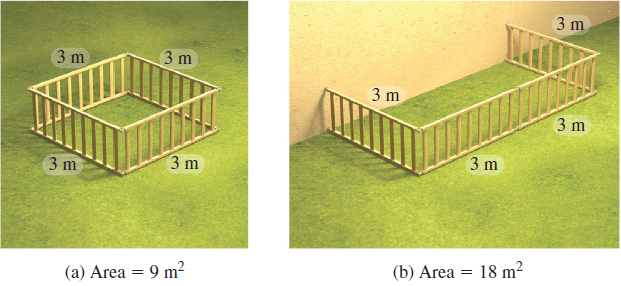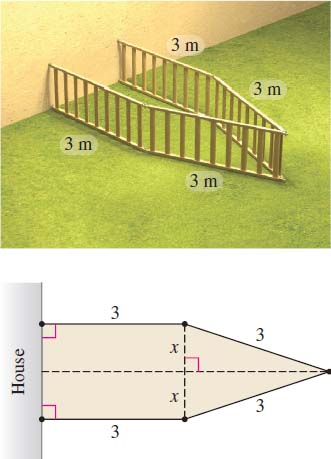EXAMPLE 3Maximizing an Area
A manufacturer makes a flexible square play yard (Figure 55a), that can be opened at one corner and attached at right angles to a wall or the side of a house, as shown in Figure 55(b). If each side is 3 m in length, the open configuration doubles the available area from 9 m2 to 18 m2. Is there a configuration that will more than double the play area?
Solution
Step 1 We want to maximize the play area A.
Step 2 Since the play yard must be attached at right angles to the wall, the possible configurations depend on the amount of wall used as a fifth side, as shown in Figure 56. We use x to represent half the length (in meters) of the wall used as the fifth side.
321
Step 3 We partition the play area into two sections: a rectangle with area 3(2x)=6x and a triangle with base 2x and altitude √32−x2=√9−x2. The play area A is the sum of the areas of the two sections. The area to be maximized is A=A(x)=6x+12(2x)√9−x2=6x+x√9−x2
The domain of A is the closed interval [0,3].
Step 4 To find the maximum area of the play yard, we find the critical numbers of A. A′(x)=6+x[12(−2x)(9−x2)−1/2]+√9−x2=6−x2√9−x2+√9−x2=6√9−x2−2x2+9√9−x2
Critical numbers occur when A′(x)=0 or where A′(x) does not exist. A′ does not exist at 3, and A′(x)=0 at 6√9−x2−2x2+9=0√9−x2=2x2−969−x2=(2x2−96)2=4x4−36x2+8136324−36x2=4x4−36x2+81324=4x4+81x4=324−814=2434x=4√2434≈2.792

The only critical number in the open interval (0,3) is 4√2434≈2.792.
Now we evaluate A(x) at the endpoints 0 and 3 and at the critical number x≈2.792. A(0)=0A(3)=18A(2.792)≈19.817
Using a wall of length 2x≈2(2.792)=5.584 m will maximize the area; the configuration shown in Figure 57 increases the play area by about 10% (from 18 to 19.817 m2).



